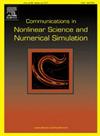基于PD控制器的延迟耦合主体群体行为分岔控制
IF 3.4
2区 数学
Q1 MATHEMATICS, APPLIED
Communications in Nonlinear Science and Numerical Simulation
Pub Date : 2025-05-13
DOI:10.1016/j.cnsns.2025.108921
引用次数: 0
摘要
如何设计控制算法来有效地调节具有感知延迟的群体行为仍然是一个巨大的挑战。本文提出了一种带有PD控制器的分岔控制方法来调节感知延迟下的群体行为。受控系统表现出三种不同状态的出现。分岔分析表明,通过选择合适的参数,可以有效地控制参数空间中的Hopf分岔和pitchfork分岔曲线,从而实现系统内部的状态转换。此外,我们的研究结果表明,PD控制器可以影响对期望系统状态的收敛速度。从理论上推导了这三种状态与物理参数的理论性质,并进行了粒子模拟来验证这些理论发现。本文章由计算机程序翻译,如有差异,请以英文原文为准。
Bifurcation control for the collective behavior of delayed-coupled agents via PD controller
How to design control algorithms to effectively regulate the collective behavior with sensing delay remains a formidable challenge. In this paper, we propose to use bifurcation control with PD controller to regulate the collective behavior under sensing delay. The controlled system exhibits the emergence of three distinct states. Bifurcation analysis reveals that the Hopf bifurcation and pitchfork bifurcation curves in the parameter space can be effectively manipulated by selecting the appropriate parameters, thereby enabling state transitions within the system. Furthermore, our findings suggest that the PD controller can influence the convergence rate towards the desired system state. Theoretical properties of these three states, in relation to physical parameters, are theoretically derived, and particle simulations are conducted to validate these theoretical findings.
求助全文
通过发布文献求助,成功后即可免费获取论文全文。
去求助
来源期刊

Communications in Nonlinear Science and Numerical Simulation
MATHEMATICS, APPLIED-MATHEMATICS, INTERDISCIPLINARY APPLICATIONS
CiteScore
6.80
自引率
7.70%
发文量
378
审稿时长
78 days
期刊介绍:
The journal publishes original research findings on experimental observation, mathematical modeling, theoretical analysis and numerical simulation, for more accurate description, better prediction or novel application, of nonlinear phenomena in science and engineering. It offers a venue for researchers to make rapid exchange of ideas and techniques in nonlinear science and complexity.
The submission of manuscripts with cross-disciplinary approaches in nonlinear science and complexity is particularly encouraged.
Topics of interest:
Nonlinear differential or delay equations, Lie group analysis and asymptotic methods, Discontinuous systems, Fractals, Fractional calculus and dynamics, Nonlinear effects in quantum mechanics, Nonlinear stochastic processes, Experimental nonlinear science, Time-series and signal analysis, Computational methods and simulations in nonlinear science and engineering, Control of dynamical systems, Synchronization, Lyapunov analysis, High-dimensional chaos and turbulence, Chaos in Hamiltonian systems, Integrable systems and solitons, Collective behavior in many-body systems, Biological physics and networks, Nonlinear mechanical systems, Complex systems and complexity.
No length limitation for contributions is set, but only concisely written manuscripts are published. Brief papers are published on the basis of Rapid Communications. Discussions of previously published papers are welcome.
 求助内容:
求助内容: 应助结果提醒方式:
应助结果提醒方式:


